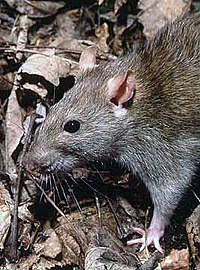
Photo from wikipedia
Background Cortical spreading depolarizations (CSDs) are associated with worse outcomes in patients with aneurysmal subarachnoid hemorrhage (SAH). Animal models are required to assess whether CSDs can worsen outcomes or are… Click to show full abstract
Background Cortical spreading depolarizations (CSDs) are associated with worse outcomes in patients with aneurysmal subarachnoid hemorrhage (SAH). Animal models are required to assess whether CSDs can worsen outcomes or are an epiphenomenon; however, little is known about the presence of CSDs in existing animal models. Therefore, we designed a study to determine whether CSDs occur in a mouse model of SAH. Methods A total of 36 mice were included in the study. We used the anterior prechiasmatic injection model of SAH under isoflurane anesthesia. A needle was inserted through the mouse olfactory bulb with the point terminating at the base of the skull, and arterial blood or saline (100 ml) was injected over 10 s. Changes in cerebral blood volume over the entire dorsal cortical surface were assessed with optical intrinsic signal imaging for 5 min following needle insertion. Results CSDs occurred in 100% of mice in the hemisphere ipsilateral to olfactory bulb needle insertion (CSD1). Saline-injected mice had 100% survival ( n = 10). Blood-injected mice had 88% survival ( n = 23 of 26). A second, delayed, CSD ipsilateral to CSD1 occurred in 31% of blood-injected mice. An increase in the time interval between CSD1 and blood injection was associated with the occurrence of a second CSD in blood-injected mice (mean intervals 26.4 vs. 72.7 s, p < 0.0001, n = 18 and 8). We observed one blood-injected animal with a second CSD in the contralateral hemisphere and observed terminal CSDs in mice that died following SAH injection. Conclusions The prechiasmatic injection model of SAH includes CSDs that occur at the time of needle insertion. The occurrence of subsequent CSDs depends on the timing between CSD1 and blood injection. The mouse prechiasmatic injection model could be considered an SAH plus CSD model of the disease. Further work is needed to determine the effect of multiple CSDs on outcomes following SAH.
Journal Title: Neurocritical Care
Year Published: 2022
Link to full text (if available)
Share on Social Media: Sign Up to like & get
recommendations!